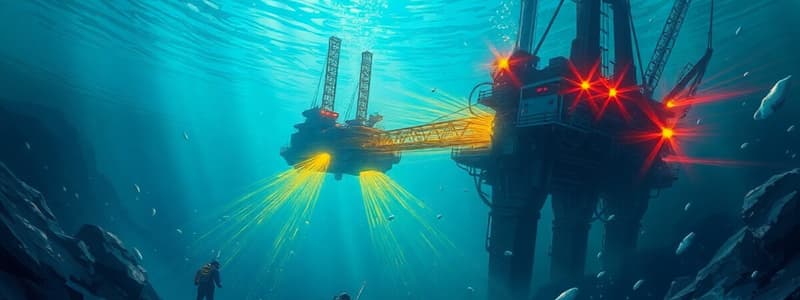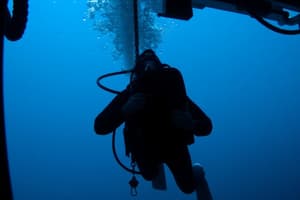Podcast
Questions and Answers
During the subsea spool tie-in operations, what primary factor led the Diving Supervisor to incorrectly assume the crane hook had reached the seabed?
During the subsea spool tie-in operations, what primary factor led the Diving Supervisor to incorrectly assume the crane hook had reached the seabed?
- The crane operator reported a 'no weight' reading on the crane wire. (correct)
- The divers confirmed audibly that no weight prevented the rigging's disconnection.
- The PHF automatically detached once it made contact with the seabed.
- Underwater cameras confirmed the hook's position on the seabed.
What immediate action demonstrated effective emergency response after the crane hook struck the diver's helmet?
What immediate action demonstrated effective emergency response after the crane hook struck the diver's helmet?
- Diver 2 promptly assisted Diver 1, and both divers returned to the dive bell. (correct)
- Deployment of additional underwater cameras to assess the situation and the diver's helmet.
- Immediate inspection of the crane hook for any signs of damage.
- The diving supervisor immediately stopped all crane operations.
To prevent similar incidents, what procedural enhancement should be implemented regarding crane pennant/stinger length?
To prevent similar incidents, what procedural enhancement should be implemented regarding crane pennant/stinger length?
- Using the shortest possible pennant/stinger to increase control over the crane hook.
- Routinely inspect the pennant/stinger for damage.
- The length of the crane pennant/stinger should maintain a safe distance between divers and the hook. (correct)
- Using a universal, standardized length for all subsea operations.
Besides adequate equipment, what is most critical to foster in subsea operations?
Besides adequate equipment, what is most critical to foster in subsea operations?
In environments with poor visibility, what alternative method can be used to track the position of equipment?
In environments with poor visibility, what alternative method can be used to track the position of equipment?
Flashcards
Adequate distance between divers and crane hook
Adequate distance between divers and crane hook
When lowering equipment subsea, the length of the crane pennant/stinger should be sufficient to maintain a safe separation between divers and the crane hook, especially in limited visibility.
Enhanced visibility aids and monitoring
Enhanced visibility aids and monitoring
In environments with poor visibility, use additional locating beacons, underwater cameras, or sonar to track equipment like the crane hook.
Reinforce communications; challenge assumptions!
Reinforce communications; challenge assumptions!
Clear communication and confirmation procedures between the dive supervisor, crane operator, and divers should be reinforced to ensure all parties are fully aware of the equipment's location at all times. Assumptions should be minimized.
Pre-operation inspections
Pre-operation inspections
Signup and view all the flashcards
Protective equipment function
Protective equipment function
Signup and view all the flashcards
Study Notes
- During subsea spool tie-in operations, a crane hook unexpectedly struck a diver's helmet.
- The incident occurred on March 6, 2025.
What Happened
- Divers were working on the seabed in poor visibility during subsea spool tie-in operations.
- After landing the pipe handling frame (PHF), the Diving Supervisor instructed the crane operator to lower the crane hook to the seabed to allow the diver to disconnect rigging from the crane.
- The crane operator reported 'no weight' on the crane wire, so the Diving Supervisor assumed the hook had reached the seabed
- The supervisor instructed the diver to disconnect the PHF from the crane.
- The crane hook unexpectedly struck the diver's helmet when the diver was positioned beneath the PHF and moving to disconnect the rigging.
- The diver was unharmed and returned to the dive bell, and the dive was aborted.
- The diver's reclaim helmet was damaged beyond repair, including the side block, but the integrity of the helmet was maintained, and the diver was unharmed.
What Went Right
- Diver 2 promptly assisted Diver 1, ensuring no injuries were sustained, and both divers immediately returned to the bell safely.
- Both divers and the crane block had locating beacons fixed to them, enabling accurate tracking.
- All procedures, lifting plans, and Job Hazard Analyses were followed throughout the operation.
- Protective equipment worked, and the diver was uninjured because the helmet absorbed the impact.
What Went Wrong
- Lowering the crane hook for PHF rigging disconnection caused it to rest on the top beam of the PHF.
- This resulted in a 'no weight' reading, leading the crane operator to assume the hook had reached the seabed.
- The hook slipped off the beam and struck the side of the diver's helmet as the diver approached the disconnection point.
What Was the Cause
- An inadequate length of crane pennant or stinger did not provide sufficient distance between the divers and the crane hook.
- Poor visibility hindered the ability to accurately observe the crane hook position.
Lessons and Actions
- Ensure adequate distance between divers and crane hook.
- The length of the crane pennant/stinger should maintain a safe distance between the divers and crane hook during subsea operations.
- Enhanced visibility aids and monitoring:
- Use alternative methods such as additional locating beacons, underwater cameras, or sonar in poor visibility.
- Reinforced communications:
- Minimize assumptions regarding equipment position.
- Reinforce clear communication and confirmation procedures between the dive supervisor, crane operator, and divers to ensure all parties are fully aware of the equipment's location.
Additional actions
- Updated project procedures to specify minimum pennant lengths for different operations.
- Conducted pre-operation inspections of all rigging and lifting equipment, including crane hooks and pennants, to ensure they meet safety standards and are appropriate for the operation.
- Updated the Job Hazard Analysis (JHA) to reflect lessons learned regarding safe distances, visibility, and communication requirements for subsea lifting operations.
Studying That Suits You
Use AI to generate personalized quizzes and flashcards to suit your learning preferences.




